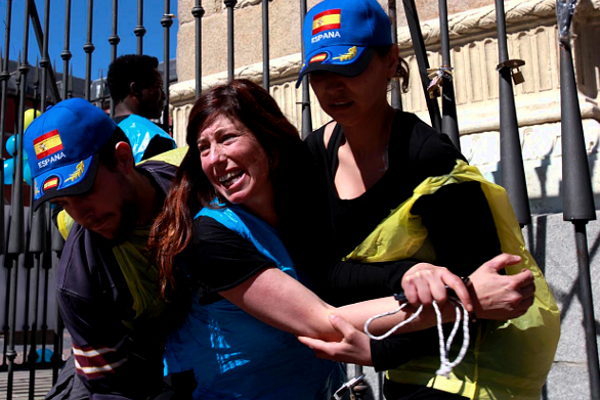
By: Christian Peñuela – July 11th, 2011
The Slutwalk in Canada, Australia, USA and England, the Marcha das Vagabundas in Brazil and the Marcha de las Putas in Honduras, Mexico, El Salvador, Spain and Venezuela, among others, has become a collective international action to protest against sexual violence towards women. Mothers, fathers, brothers, ‘whores and sluts’, members of the LGBTI community and children have taken the streets to reclaim the dignity of women.
Shouting “No means no”, those who participate in this particular form of protest reject the use of women as sex objects, as well as harassment and violence committed against them in public and private spheres. The interest in the word ‘slut’ comes from the emotional burden it carries and from the way society imposes a ‘valid’ way of dressing, acting and valuing their body and femininity on women. However, these demonstrations have little to do with sex work and sex workers do not make part of them; quite the contrary, they gather women and men of all ages and social backgrounds that reject discrimination and aggression towards the female population.
It all started last January 24th, when a Canadian policeman, Michael Sanguinetti, made some discriminatory comments during a civil security event held at the University of New York. The officer declared that “women should avoid dressing like sluts in order not to be victimized”. This statement aroused the women’s movement in the city of Toronto (Canada) to a state of indignation and they soon began a fight for the transformation of the social imaginary that stigmatizes women as responsible for the violence against them. On April 3rd, the movement staged a large protest where thousands of women, with the support of the LGBTI community and various social organizations, marched wearing heels, tights, pronounced cleavage, garters and even naked to demand respect for the right to body and a to a life free of violence.
Inspired by this first protest, fifteen similar demonstrations have been carried out around the world and many more are being planned by women’s organizations, which have included particular issues of each country among the reasons that have fueled this collective action in Latin America: in Mexico against femicide; in Honduras against the unprecedented increase of sexual violence since the coup d’état; and in Argentina in favor of the registration of sex offenders.
In Colombia, there have been many experiences of mobilization against violence towards women. From the massive demonstrations that took the streets of major cities on March 8th and November 25th to tens of symbolic acts in different parts of the national territory, which have served to expose the critical situation regarding human rights in this country.
Two of these efforts to raise public awareness and transform the reality of violence against women in the country occur in different ends of Bogota, both for their location as for their social and economic situation. One of them took place in the Parque Fundacional de Usaquén, where the campaign Women in the city placed human-scale silhouettes of women to understand the behavior that people have in relation to them. Similarly, since 2007 several women’s organizations of the District of Bosa participate in sit-ins on the first Friday of each month to report cases of sexual violence under the slogan: “No more girls, boys or women raped in Bosa”.
According to the «Report on sexual violence and femicide in Colombia,» presented in 2008 to the Inter-American Commission on Human Rights by the organizations Corporación Casa de la Mujer, Mujeres que Crean, Ruta Pacífica de las Mujeres y Vamos Mujer, the situation in Colombia is worrisome for the types of aggression and the profile of the victims: “one in every three victims of violence is in the age range of 10 to 14 years” and “one in every five victims is in the age range of 5 to 9 years […] girls are the most sexually assaulted”, the report says.
Additionally, both the aforementioned report and other diagnostic reports on women’s rights say homicide and sexual violence against women have been territorial control mechanisms used in the war that takes place in Colombia. The report “Sexual Violence in Colombia: A Weapon of War” prepared by Oxfam International in 2009 states that “widespread and systematic sexual violence against women, used by all armed groups as a weapon of war and as part of a broader strategy of terror against the civilian population, may be one of the key factors to consider this offense as a crime against humanity. This reality contrasts with the impunity and invisibility that have silenced and perpetrated these crimes».
__________
Translated to English by Lorena Elejalde.
Si encuentras un error, selecciónalo y presiona Shift + Enter o Haz clic aquí. para informarnos.



